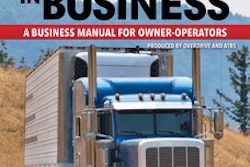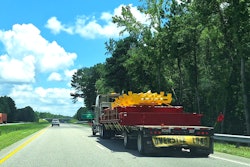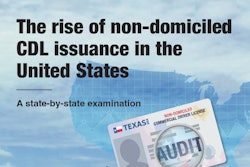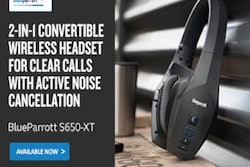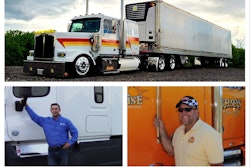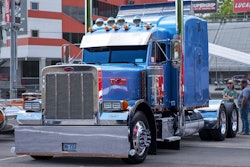Trucking news and briefs for Friday, July 25, 2025:
Year-long $5 million cargo theft conspiracy ends with trial finding serial offender guilty
A member of a cargo theft ring has been found guilty for his role in a year-long conspiracy to steal millions of dollars in high-end electronics and other products from shipping facilities and trucks in southern Indiana and other states.
A federal jury found Juan D. Perez-Gonzalez, 51, of Florida, guilty of conspiracy, possession of goods stolen from interstate commerce, and interstate transportation of stolen property.
Five co-conspirators in this case have entered guilty pleas for their roles in the operation and will be sentenced at later dates:
- Carlos Enrique Freire-Pifferrer, 46, of Louisville, Kentucky -- Pled guilty to conspiracy and two counts of interstate transportation of stolen property. Sentencing set for Aug. 22.
- Jose Antonio Gomez-Pifferrer, 33 and also of Louisville -- Pled guilty to conspiracy and two counts of interstate transportation of stolen property. Sentencing set for Oct. 24.
- Dalwy De Armas-Rodriguez, 38, Louisville -- Pled guilty to conspiracy. Sentencing set for Aug. 28.
- Luis Velazquez, 58, of Jacksonville, Florida -- Pled guilty to conspiracy and interstate transportation of stolen property. Sentencing set for Aug. 22.
- Richard Alameda, 47, also of Florida -- Pled guilty to conspiracy. Sentencing set for Sept. 4.
According to court documents and evidence introduced at trial, between December 2021 and May 2023, Perez-Gonzalez and his co-conspirators conspired to steal tractor-trailers containing commercially available, high-end electronics and other items, which they later resold at a discount for profit.
The co-conspirators traveled from various locations, including Indiana, Kentucky and Ohio, to target various distribution facilities used by national companies such as Meta, Microsoft, and L Brands. The group surveilled these facilities and followed tractor-trailers as they departed. When a driver stopped to rest, refuel, or park, the conspirators stole the entire rig.
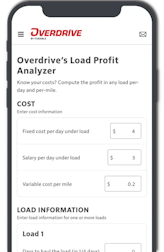
[Related: Owner-op jailed after unwitting participation in cargo theft: Cautionary tale, mitigating risk]
In many instances, the group abandoned the stolen tractor nearby and reattached the trailer to a different tractor they operated. To evade law enforcement, they painted over logos and identifying numbers and used different license plates on the stolen trailers.
They transported the stolen cargo to Miami, Florida, where it was sold to buyers, including co-defendant Alameda, for a fraction of its retail value.
The group carried out at least 14 separate thefts of more than $2 million in Oculus virtual reality headsets from a Meta facility; $940,000 in Microsoft products; $1 million in Bath & Body Works and Victoria’s Secret merchandise; $669,000 in Harmon-JBL audio products; $180,000 in Logitech products; and $480,000 worth of Bose audio speakers, among other stolen items -- totaling nearly $5.3 million.
Perez-Gonzalez has been at the cargo-theft business for some time -- the recent guilty conviction marks his third federal conviction. In 2009, he stole two semi-trailers loaded with $500,000 worth of liquor from a distribution facility in Jeffersonville, Indiana. He was convicted in the Western District of Kentucky and sentenced to 23 months in prison. Then in 2014, while on supervised release for the 2009 offense, Perez-Gonzalez again engaged in a scheme to steal cargo from tractor-trailers, using nearly identical methods as the most recent offense. He was convicted in the Southern District of Indiana and sentenced to 105 months in prison.
[Related: Cargo theft soared 13% in Q2, Class 7-8 used-truck prices up a hair to flat]
National Safety Council urges DOT to reconsider speed-limiter mandate withdrawal
The National Safety Council, best known among Overdrive readers for its preventable/nonpreventable Accident Review Committee, said in a release posted to the council's website that it was urging the U.S. Department of Transportation to reconsider its recent rollback of Federal Motor Carrier Safety Administration efforts to require speed-limiting device use in heavy trucks.
Lorraine Martin, National Safety Council CEO, called the move "a disappointing rollback of a decades-long effort to reduce speed-related fatalities involving large commercial vehicles. The National Safety Council urges USDOT to reconsider its decision, which will cost lives."
[Related: Speed-limiter mandate gets the axe: Proposals officially withdrawn by U.S. DOT]
NSC cited statistics showing that speeding was a factor in 29% of total traffic fatalities in 2023, killing 11,775, or an average of more than 32 people on a typical day in the United States.
Excess speed combined with heavy vehicles can have deadly results, NSC said.
The Council cited research from 2012, an FMCSA study of fleet crash data that found trucks equipped with speed-limiting devices had a significantly lower crash rate than those without such devices. According to USDOT, NSC said, truck speed limiters, if set to a maximum speed of 65 mph, might save more than 200 lives and prevent nearly 5,000 injuries annually.
[Related: Trucker John Doe v. Porsche's Grand Prix-style pass on city road: Preventable or not?]
PennDOT launches campaign to combat bridge strikes
The Pennsylvania Department of Transportation began a public awareness campaign aimed at helping drivers avoid hitting low bridges with vehicles. The “Check Your Height, Know It’s Right” campaign -- announced as part of a multi-state collaboration -- encourages motorists to know their vehicle height and check that it will safely fit under bridges en route. Vehicle strikes to the tops or sides of bridges, commonly known as bridge hits, damage vehicles and infrastructure, cause traffic delays, and put the public and emergency responders at risk, PennDOT said.
According to PennDOT data, in the 10 years between 2013 and 2023, there were more than 600 strikes to bridges or other overhead structures in the state.
In Pennsylvania, vehicles and loads taller than 13’6” must be permitted. All bridges with a vertical clearance less than 14’6” are signed with low-clearance warnings, both at the bridge and in advance of the structure. Drivers should always watch for and adhere to signage indicating bridge heights and not rely solely on navigation devices, which do not consider vehicle height when giving route guidance, the department noted.
[Related: Fleet shut down after bridge strike]
The campaign will involve public and industry outreach targeting CDL holders and non-commercial drivers operating commercial trucks, leased trucks (such as delivery and moving box-type trucks), and recreational vehicles.
Crash data shows that drivers may not always consider vehicle height and related restrictions during operation, PennDOT said. A typical 26-foot moving/delivery truck may have a height ranging from 11’ to 13’6”, for example. The campaign also reminds drivers to lower truck beds and check the height of equipment they’re hauling.
Drivers can use 511PA to check their route for low-clearance bridges (less than 13’6”) using the “Low Bridge” map layer. When the map layer is on, low bridges are indicated with a bridge icon that users can click for more information about the location.
Additionally, in 2023 the Shapiro Administration launched a 511PA mobile app enhancement allowing drivers to specify vehicle type -- either commercial or passenger vehicle. If commercial vehicle is selected, vehicle restrictions and low-bridge data is turned on in drive mode by default and audio alerts can be heard along your route.
Where possible, PennDOT and other bridge owners increase the vertical clearance under bridges during rehabilitation and reconstruction projects to reduce the chances of strikes. Over the past 10 years, more than 160 bridges with 16’5” or less of vertical clearance were raised by at least 3 inches during replacement.
PennDOT is adopting the “Check Your Height, Know It’s Right” campaign with the support of The Eastern Transportation Coalition, a partnership of 19 states and D.C.
[Related: $100,000 fines, jail time proposed as carriers keep hitting bridges in British Columbia]
Railroad-support carriers get full HOS exemption renewal
Trucking companies operating in support of the railroad industry have received a full exemption renewal from the Federal Motor Carrier Safety Administration after the agency granted a provisional renewal earlier this year.
R.J. Corman Railroad Services, Cranemasters and the National Railroad Construction and Maintenance Association first received the exemption in 2020 that allows their employees who operate under hours-of-service rules to respond to “unplanned events” that occur outside of or extend beyond the employee’s normal working hours. It allowed drivers to operate beyond the 14th hour after coming on duty and driving after accumulating 60 hours of on-duty time in seven days or 70 hours in eight days.
FMCSA provisionally renewed the waiver in March while accepting public comments on a full five-year renewal. The exemption is now in effect through March 4, 2030.
Under terms of the waiver, the HOS relief is limited to the trip toward the scene of the unplanned event; drivers will record working time at the scene as on-duty, not-driving time; and drivers will get the requisite rest before driving on a public road post-incident.
“Because such events happen only occasionally and not during a predictable number of times per week or per month, drivers would not operate CMVs after the 14th hour of coming on duty as a regular part of their schedules,” FMCSA said in granted the full renewal. “Drivers would not regularly operate CMVs after accumulating 60 hours or 70 hours of on-duty time during seven or eight consecutive days. Drivers’ standard schedules would include adherence to the 14-hour rule and adherence to the 60- and 70-hour rules.”
[Related: FMCSA provisionally renews HOS relief for railroad-support companies]
